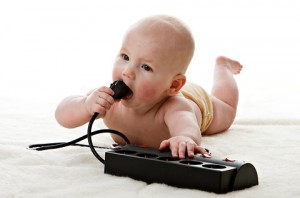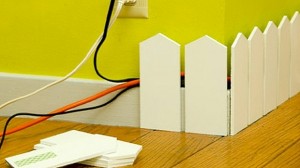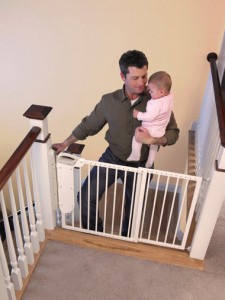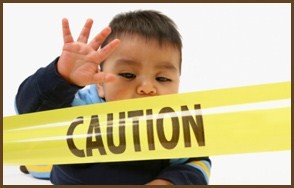Childproofing Your Home : What Every Parent Should Know
Safe and sound
Parents worry endlessly about how to protect their children from stranger abduction and violence, but many overlook one of the biggest threats to their children’s safety and well-bein g — their own home. Experts say that children between the ages of 1 and 4 are more likely to be killed by fire, burns, drowning, choking, poisoning, or falls than by a stranger’s violence.
g — their own home. Experts say that children between the ages of 1 and 4 are more likely to be killed by fire, burns, drowning, choking, poisoning, or falls than by a stranger’s violence.
About 2.3 million children are accidentally injured every year and more than 2,500 are killed, according to the U.S. Centers for Disease Control and Prevention. That’s why it’s so important to carefully childproof your home.
If home safety measures seem overwhelming, our childproofing checklists can help. They let you see at a glance what to do before your baby arrives, before your baby crawls, and before your baby starts toddling and climbing. You’ll also find safety tips in our articles about childproofing your nursery, kitchen, and bathroom.
Here are some additional recommendations — along with some revealing statistics — about what you need to do to keep your baby safe at home.
Gadgets galore
You’ll find all kinds of gadgets for sale that can really help your home childproofing efforts. Or (if you can afford it), hire a professional childproofer to choose and install safety devices for you.
Keep in mind that gadgets are no substitute for your eyes and ears.
“The best device is still supervision. I’d rather not recommend a product than suggest one that gives parents a false sense of security,” says Anne Altman, a childproofing consultant and contractor in Santa Rosa, California.
Scope out the territory
The most effective way to ensure your baby’s safety is to take a baby’s-eye view of your home. Get down on your hands and knees and see how things look from down there.
What’s within reach? What looks tempting? Where would you go if you could crawl, toddle, or walk?
This will help you figure out which cupboards, drawers, and other spaces your child might get into. As he starts walking and climbing, you’ll have to reevaluate again, looking higher each time.
Carefully lock up or stow away every potential poison or other hazard, including cleaning products, medicines, vitamins, and knives. Use gates to limit your child’s access to areas of your home that might contain dangerous items.
Keep an eye out for tiny objects that your baby could choke on. Pick up any coins, marbles, beads, paper clips, and other small objects you find on low tables or the floor or in low drawers or cupboards.
Be watchful when you have visitors, too. No matter how carefully you’ve childproofed the house, Great-Aunt Jane probably hasn’t applied your standards to her purse. Aspirin, lipstick, medications, and other items that people typically carry with them are dangerous to small children.
Protect outlets
It’s a good idea to protect electrical outlets with outlet covers. Unfortunately, the removable little plug-in caps can easily end up in your baby’s mouth. Instead, replace the outlet covers themselves – at least those that are accessible – with ones that include a sliding safety latch.
If you’re using extension cords in your home, cover any exposed outlets with electrical tape.
You’ll have to reevaluate these precautionary measures as your child grows. “Childproofing is an ongoing process,” says Altman. “The gate you put at the top of the stairs for your 1-year-old may become his favorite climbing structure when he’s 2.”
Use caution with furniture and fixtures
According to the U.S. Consumer Product Safety Commission (CPSC), more than 16,000 children under the age of 5 went to the emergency room in 2006 with injuries caused when television sets, bookcases, and other furniture and appliances tipped over on them. Between 2000 and 2006, more than 130 young children died from furniture tip-overs.
Large or heavy bookcases, dressers, and appliances are real hazards: Bolt whatever you can to the wall. Push items like televisions back from the edge of the furniture they’re on or move them out of reach, and then secure them, too. Always put heavier items on bottom shelves and in bottom drawers to make furniture less top-heavy.
Babies start pulling up on furniture shortly after they start crawling. And when they learn how to climb, watch out! Some children scale counters, bookcases, and anything else they can grab on to. Place floor lamps behind other furniture so that their base is out of your child’s reach.
Keep dresser drawers closed when you’re not using them – they make perfect ladders. And be particularly careful to fully close file cabinet drawers, because pulling out one drawer could cause the cabinet to fall over.
Furniture corners are another common hazard, especially those found on coffee tables. Cover all sharp corners and hearth edges with bumpers to soften the impact if your child falls.
Install gates
Most parents consider safety gates essential childproofing tools. They allow you to open outside doors for air while keeping your child indoors, they contain him within a designated room, and they block his access to dangerous stairways and forbidden rooms (such as the bathroom or kitchen).
Unfortunately, if out-of-date or used improperly, safety gates can themselves pose a hazard to children. In general, look for gates that your child can’t dislodge but that you can easily open and close. (Otherwise, you’ll be too tempted to leave them open when you’re in a hurry.)
Never use pressure gates at the top of stairs. Instead, install a gate that screws to the wall – it’s much more secure.
It’s best to buy brand-new safety gates, making sure they display a seal from the Juvenile Products Manufacturers Association (JPMA).
Choose a gate with a straight-slat design rather than an older accordion-style gate with V-shaped openings, says Altman. “They can pose an entrapment and strangulation hazard.”
Check ties on blinds and curtains
According to the CPSC, the cords on window coverings are a frequent cause of strangulation of children, killing a child between the ages of 7 months and 10 years every month in the United States.
Window blinds pose a particular hazard because a baby’s neck could become trapped in the cords that raise the blinds or run through the slats. A child can become entangled in a looped window cord and strangle in a matter of minutes. Use cordless window coverings wherever possible, and avoid placing your baby’s crib near a window.
If you have curtains with pull cords in your home, either cut off the pull cords or use cord shorteners or wind-ups to keep them out of reach. You can also replace a cord loop with a safety tassel. Corded window coverings sold since November 2000 have attachments on the pull cords to prevent a loop from forming between the slats.
If you bought your blinds before November 2000, visit the Window Covering Safety Council’s website or call (800) 506-4636 to order a free repair kit.
Secure your windows and doors
According to the CPSC, every year about eight children under the age of 5 die from falling out of windows in the United States, and more than 3,000 are injured.
Always open double-hung windows from the top or fit them with locks to prevent small children from opening them.
Low windows shouldn’t open more than 4 inches. Window stops are available that can prevent windows from opening more than this. Some newer windows come with window stops already installed.
Window screens are not strong enough to prevent falls. To make windows safe, install window stops or window guards, which screw into the side of a window frame, have bars no more than 4 inches apart, and can be adjusted to fit windows of many different sizes.
According to industry standards announced by the CPSC in June 2000, the guards must fit snugly but not so securely that an older child or adult can’t remove them in case of an emergency. (The CPSC considers non removable window guards safe for windows on the seventh floor and above.)
Keep furniture away from windows to prevent children from climbing up and reaching the windowsill. Tragically, thousands of children fall from windows every year.
Use doorstops or door holders on doors and door hinges to prevent injuries to hands. Children are prone to getting their small fingers and hands pinched or crushed in closing doors.
Prevent poisoning
According to the American Association of Poison Control Centers, more than 1.2 million possible poisonings of children under age 5 were reported in 2009. The CPSC reports that about 30 U.S. children die from poisoning each year.
Be prepared. Keep the number for the national poison control center – (800) 222-1222 in the United States – and your local emergency numbers close to every phone.
Store poisonous products out of your child’s reach. Put safety locks on all cabinets and drawers that hold bug sprays, cleaning products, medications, and other potential poisons. Even some houseplants can be harmful if ingested.
Dispose of old or outdated medications. Most medicines shouldn’t be flushed down the toilet or poured down the drain, as they could contaminate the water supply. Check the label on the bottle: If it’s safe to flush leftover medicine, it will say so on the label.
Watch out for hidden poisons. Not all poisons are easy to spot. Carbon monoxide is an odorless and colorless gas produced by malfunctioning fuel-burning appliances such as furnaces, water heaters, ovens, stoves, gas dryers, and emergency generators. Although you can’t see it, smell it, or taste it, carbon monoxide gas can be deadly.
To protect your family, install a carbon monoxide detector in every sleeping area in your home, including the nursery. Check the batteries every spring and fall when you change your clocks. If the alarm goes off, leave your home immediately and call 911 or the local emergency number.
Look out for lead. If you live in a building constructed before 1978, it may contain lead paint. Lead paint is especially dangerous to your child if it’s flaking or peeling. Lead can also be found in tap water from older pipes that are lined or soldered with lead. If your home was built before 1978, or if there’s any other risk of lead exposure, talk to the doctor about getting your child’s blood tested for lead.
Breathing lead dust or fumes or swallowing anything with lead in it can give a child lead poisoning, Lead poisoning can cause learning disabilities, kidney disease, brain damage, delayed growth, and other problems.
If there’s exposed or deteriorating lead paint in your home, have a licensed professional either remove it completely or cover it with an approved sealant. Until the lead can be removed, wash your child’s hands and face, as well as his toys, often to reduce his exposure to lead-contaminated dust.
Prevent drowning
According to the CPSC, more than 430 children under age 5 drowned between 2005 and 2009 – not in a pool, but in their own home. Accidental drowning is the leading cause of death for children ages 1 to 4.
Tubs, toilets, and even buckets of water are all potential dangers. That’s why it’s important to practice water safety at home.
Most in-home drowning deaths involve babies in bathtubs. Never leave your baby unattended in the tub – even if he’s in a ring or bath seat. Supervise your child whenever he’s in the bathroom, and install a safety latch on your toilet lid to prevent him from accidentally falling in.
Infants and toddlers can drown in as little as a few inches of water, according to the CPSC. This seemingly unlikely scenario happens because young children are top-heavy. If they lose their balance (as they often do) while peering into a toilet or bucket, they can fall in headfirst and get stuck.
Never leave a bucket of water or other liquid unattended. If you’re using a bucket of water for mopping or cleaning, pour out the water as soon as you’re finished.
Finally, take great care around pools and hot tubs. Wading pools are a major risk for drowning: More than 200 children in the United States have drowned in kiddie pools in the past decade. If you have a wading pool, drain it and store it upright after each use.
If you have a permanent pool, enclose it with a fence that’s at least 4 feet high, and lock the gate leading to the pool after each use. Always secure and lock the cover on your spa or hot tub.
Prevent fires
Nearly 2,500 children in the United States were injured or killed in residential fires in 2007, and more than 1,000 of those children were under the age of 4, according to the Federal Emergency Management Agency (FEMA).
Experts say that a working smoke alarm can cut in half the chances of dying in a fire. Install smoke alarms in every room of the house. Check them monthly to be sure they’re working, and change the batteries at least every year.
Consider installing smoke alarms that use long-life (ten-year) batteries.
Consider keeping a fire extinguisher in your home, and have it serviced or checked according to the manufacturer’s instructions. Check FEMA for advice on when and how to use a fire extinguisher.
Start talking to your child about the dangers of fire. Make an evacuation plan and practice your fire escape route regularly.
Do you hate the feel of flame-retardant sleepwear? Softer, non-flame-retardant garments can be okay under certain conditions. See Childproofing Your Nursery for details.
Prepare for an emergency
Program emergency numbers into your home phones and cell phone. Keep a list of these numbers close to each phone in your home and give the list to all caregivers.
Have on hand the local poison control number, or the number for the national poison control center. That number will immediately put you in contact with the closest center.
Stock up on first-aid supplies. Make sure babysitters and other caregivers know where to find these supplies in your home and how to respond in an emergency.










